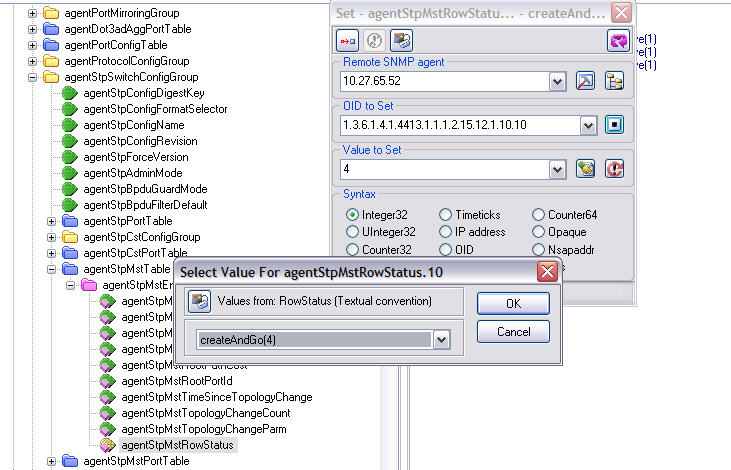Using SNMP to Configure MSTP
For instance 2, set the value to 64.
-
Use the objects in dot1qVlanStaticTable (in dot1qVlan in the QBRIDGE-MIB module) to create VLANs 10 and 20.
-
To enable spanning tree globally, set the agentStpAdminMode object in the 200 Series-SWITCHING-MIB module to enable (2).
The full path to the object is
iso(1).org(3).dod(6).internet(1).private(4).enterprises(1).broadcom(4413).
broadcomProducts(1).fastPath(1).fastPathSwitching(1).agentConfigGroup(2).agentStpSwitchConfigGroup(15).agentStpAdminMode(6).
-
Use the agentStpConfigName object in the agentStpSwitchConfigGroup to change the name so that all the bridges that want to be part of the same region can form the region.
-
Use the agentStpMstRowStatus object in the agentStpMstTable to create MST instances 10 and 20.
-
Use the agentStpMstBridgePriority object to set the bridge priorities for MST 10 and MST 20:
- For MST ID 10, set the value to 16384 to make it the root bridge.
- For MST ID 20, set the value to 61440 to ensure the other bridge is the root bridge.
-
Use the agentStpMstVlanRowStatusAssociate object in the agentStpMstVlanTable to associate MST instance 10 to VLAN 10 and MST instance 20 to VLAN 20.
- For MST ID 20, the OID to set is 1.3.6.1.4.1.4413.1.1.1.2.15.14.1.1.10.10 (the final .10 is the VLAN ID)
- For MST ID
20, the OID to set is 1.3.6.1.4.1.4413.1.1.1.2.15.14.1.1.20.20
Set the value
to CreateAndGo (4).
-
Use the agentStpPortState in
agentStpPortTable under agentStpSwitchConfigGroup to enable STP on interface 1/0/1
and interface 1/0/2.
For instance 1 and 2, set the value to enable
(1).
-
Use the agentStpMstPortPriority object in agentStpMstPortTable to change the port priority on interface 1/0/2 to force the port to be the root port on the non-root bridge.
